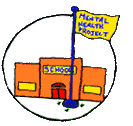|
More and more reports are highlighting the abuse of prescription medications. And, as always, abuse among kids is a major concern. Drug abuse is a constant worry for parents and schools. It becomes even more frightening around the end of the school year when so many teens are celebrating and partying. From what we hear, abuse of prescription drugs is increasingly part of the scene.
|
How Big is the Problem?
The 2002 National Survey on Drug Use and Health warned that: "Kids as young as 12 are trying or using prescription medications non-medically – to get high or for ‘self-medicating.' Pharmaceuticals are often more available to 12 year olds than illicit drugs because they can be taken from the medicine cabinet at home, rather than marijuana which necessitates knowing someone who uses or sells the drug. Also, pills may have a perception of safety because they are easier to take than smoking pot or drinking alcohol and are professionally manufactured in a lab."
More specifically that survey found that:
- 4 types of prescription medications are commonly abused – pain relievers, stimulants, sedatives and tranquilizers. Eleven percent of teens (aged 12-17) reported lifetime non-medical use of pain relievers and four percent reported lifetime non-medical use of stimulants.
- Painkillers are the most common pharmaceutical abused by teens, especially by younger teens. Stimulant abuse is more common among older teens and college students than younger teens. Girls are more likely to be current (past month) abusers of prescription medications than boys (4.3 vs. 3.6 percent).
|
|
Here is a flavor of what 2005 reports have indicated:
- From: Preventing Teen Abuse of Prescription and Over-the-counter Medications (2005)
(The Partnership for a Drug Free America – http://www.drugfree.org)
"For teens, prescription and over-the-counter medications may have appeal for a number of reasons. They are easily accessible. They are perceived as safe when compared with street drugs. They are legal, doctor-prescribed and FDA-approved.
The latest annual study on teen drug use from the Partnership for a Drug-Free America reports that an alarming number of teenagers are abusing a variety of prescription (Rx) and over-the-counter (OTC) medications to get high. Millions of teens report abusing Rx painkillers, Rx stimulants and OTC cough medications to get high. Medications can be abused in a number of ways. Some teens simply swallow the pills or drink liquids; others may crush pills before snorting or smoking the powder. Still others melt or dissolve the medications and then inject them. Another popular way of abusing prescription drugs is to mix them with alcohol and street drugs into ‘cocktails'."
- From: the annual tracking study report by the Partnership for a Drug Free America (2005) (http://www.drugfree.org/portal/drugissue/features/prescription_medicine_misuse)
- "1 in 6 teens has abused a prescription pain medication"
- "1 in 10 report abusing prescription stimulants and tranquilizers"
- "1 in 11 has abused cough medicine"
- "Many teens think these drugs are safe because they have legitimate uses"
- From: Prescription Drugs: Abuse and Addiction (2205)
(The National Institute on Drug Abuse – http://www.drugabuse.gov/PDF/RRPrescription.pdf)
"The nonmedical use or abuse of prescription drugs is a serious and growing public health problem in this country. ... an estimated 48 million people (ages 12 and older) have used prescription drugs for nonmedical reasons in their lifetimes. This represents approximately 20 percent of the U.S. population."
"Youth who use other drugs are more likely to abuse prescription medications. According to the 2001 National Household Survey on Drug Abuse (now the NSDUH), 63 percent of youth who had used prescription drugs nonmedically in the past year had also used marijuana in the past year, compared with 17 percent of youth who had not used prescription drugs nonmedically in the past year."
"Data from the 2003 NSDUH indicate that 4.0 percent of youth ages 12 to 17 reported nonmedical use of prescription medications in the past month. Rates of abuse were highest among the 18-25 age group (6.0 percent). Among the youngest group surveyed, ages 12-13, a higher percentage reported using psychotherapeutics (1.8 percent) than marijuana (1.0 percent). The NIDA Monitoring the Future survey of 8th-, 10th-, and 12th-graders found that ... 5.0 percent of 12th-graders reported using OxyContin without a prescription in the past year, and 9.3 percent reported using Vicodin, making Vicodin one of the most commonly abused licit drugs in this population. Past year, nonmedical use of tranquilizers (e.g., Valium, Xanax) in 2004 was 2.5 percent for 8th-graders, 5.1 percent for 10th-graders, and 7.3 percent for 12th-graders. Also within the past year, 6.5 percent of 12th-graders used sedatives/ barbiturates (e.g., Amytal, Nembutal) nonmedically, and 10.0 percent used amphetamines (e.g., Ritalin, Benzedrine)."
"The abuse of certain prescription drugs-opioids, central nervous system (CNS) depressants, and stimulants- can alter the brain's activity and lead to addiction. While we do not yet understand all of the reasons for the increasing abuse of prescription drugs, we do know that accessibility is likely a contributing factor. ... some online pharmacies dispense medications without a prescription and without appropriate identity verification, allowing minors to order the medications easily over the Internet."
What to Do?
As with all substance abuse and other risky behaviors, the basic questions that arise still have only limited answers. For example:
- Why do kids take such risks?
- What preventive interventions work?
- What are the positive and negative outcomes of current efforts to discourage risky behaviors?
- How best to help after a problem has developed?
- Obviously, the more we know, especially about what motivates the behavior, the better our chances of doing something effective. And, this involves understanding personal and social motivation.
- Obviously, the better we related to kids, the more likely we can guide and counsel them and the more likely we will be in a position to help if a problem arises.
- Obviously, efforts should be taken to safeguard medications at home, school, etc. (e.g., keeping them out of easily accessible places; ensuring appropriate school policies for distributing medications to students are in place).
- And clearly, if a youngster has a substance abuse problem, treatment should be pursued quickly. To contact SAMHSA's substance abuse treatment 24-hour helpline, call 1-800-662-HELP (1-800-662-4357) or visit the Web site at http://www.findtreatment.samhsa.gov/.
|
|
Programmatic Approaches to Prevention
Over the years, four major prevention strategies have prevailed:
- school and public education campaigns to enhance knowledge about substances
and present a negative view about their impact,
- skill training to enhance positive social coping, with a major emphasis on resisting
peer pressure,
- multifaceted school programs,
- multifaceted community programs.
The best available evidence indicates that information-oriented strategies alone have little impact. More promising are skill training programs that
- include a wide r
ange of personal and social skills designed to enhance general competence and curtail interest in substance use,
- pursue implementation in ways that ensure skills are learned,
- provide subsequent "booster inoculations."
However, an emphasis on skills, per se, also is insufficient. (It is clear that lack of skills does not inevitably lead to drug abuse, and some very socially adept youngsters are drug abusers.) Thus, multifaceted programs are emerging in an attempt to influence not only youngsters, but their families, schools, neighborhoods, and the media. Such approaches usually include strategies to develop cognitive and behavioral skills, change school and community norms and practices, and enhance social supports.
|
|
Resources
See the Center Online Clearinghouse Quick Find on Substance Abuse Prevention and Intervention – https://smhp.psych.ucla.edu/qf/p3001_03.htm
There you will find overviews, articles, and resources aids developed by the Center, such as:
- Creating School and Community Partnerships for Substance Abuse Prevention Programs
- Substance Abuse: Indicators and Screening
- Substance Abuse Prevention: Toward Comprehensive, Multifaceted Approaches
- Lessons Learned: Prevailing Approaches to Substance Abuse Prevention
- Substance Abuse
- Students and Psychotropic Medication: The School's Role
And, you will find links to a variety of other resources and Centers.
BUT, don't limit your thinking to this one risky behavior/barrier to learning! Remember, that youngsters who engage in one risky behavior engage usually are or will engage in more than one such endeavor. Moreover, from a broad school and home perspective, we need to be concerned about neighborhood, family, school and peer, as well as individual factors. So, use the Center's Online Clearinghouse Quick Find's for exploring ways to enhance a wide range of school and community practices and enhance social supports.
The following Quick Finds are relevant:
- Classroom Climate/Culture
- Classroom-focused Enabling
- Learning Supports: Enabling Students
to Succeed
- Mentoring
- Motivation.
|
- Parent/Home Involvement in Schools
- Prevention for Students "At Risk"
- Resilience/Protective Factors
- Self-Esteem
- School-Community Partnerships
- Youth Development
|
|
|
![]()


